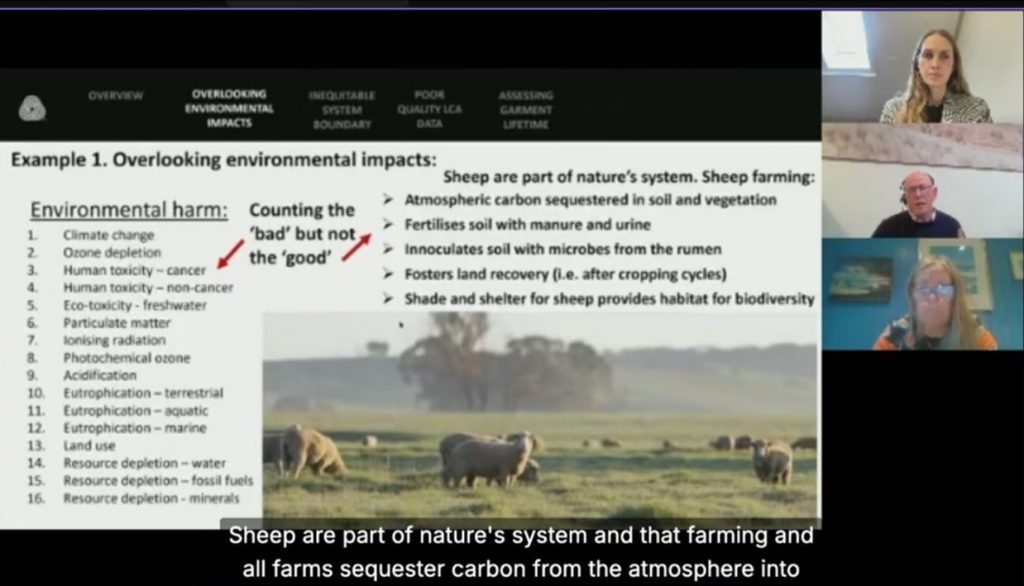The Good Wool Collective’s first webinar

A new initiative from Sweden has surfaced, The Good Wool Collective, started by Lisa Bergstrand. As part of their inaugural webinar, Australian Wool Innovation’s Angus Ireland and I gave talks.
The theme was the shortcomings of EU’s Product Environmental Footprint (PEF) and how it disadvantages natural fibers. The audience was mainly Nordic brands, but also some from further afield.
Lisa Bergstrand is a wonderful Swedish woman with an extensive design background who has embraced wool and its benefits, while Angus Ireland has been an important driver in the PEF process, and for wool’s sustainability credentials, and part of the ongoing work in PEFCRs. He is Program Manager for Fibre Advocacy and Eco Credentials at AWI, with extensive experience in wool’s environmental impact and advocacy in EU sustainability initiatives.
During the hour and a half long webinar with breakout-rooms towards the end, Angus Ireland first described the role of the wool industry in the PEF process, but also the work outside ‘the box’ in Make The Label Count (click here), and who are key players in this landscape. Next, he went on to PEF’s 16 parameters, with details about shortcomings and how plastic waste and microplastic release are not accounted for. With recent publications from Nature (click here for access) and from Changing Markets Foundation, have more or less upended the arguments that we do not have enough knowledge on microplastic release during laundering (a main argument from industry), as the Precautionary Principle is now being called into action, as laundering only represents a microscopic percentage of the total release over time, according to the Nature study.

The endemic bad quality of data and questionable parameters were Angus Ireland’s main focus. He also brought into play Consumption Research Norway’s research that relates to duration of service, that France’s Ecobalyse has been sniffing around, alongside the natural fiber sector seeing a ‘French opening’ with ADEME’s approach (sorry, only Scandinavians will see the humor in a French opening).
There is hope, as Angus Ireland described, even though the new LCA commissioned and peer-reviewed, still has not been accepted un GaBi – the database used by the EU – a process that has taken close to two years with no results so far. The Holistic Durability Working Group in PEF for apparel and footwear will hopefully succeed in their work to make for a more even playing-field.
Next up was myself, questioning whether natural fibers will ever get a fair rating in LCAs. I did a historic backtrack to the Made-By assessment tool in 2011 (wool labelled as ‘red’, recycled polyester as ‘green’) and fast forwarded to the Pulse of Fashion Report in 2017, where recycled polyester is what consumers should be ‘enhanced’ to choose. Certainly, over cotton, but obviously over all natural fibers. Amazing Grazing and other wool projects, such as the Textile farmer were introduced to the audience.
Alternative thinking needed
Changing Markets Foundation recent report Fashion’s Plastic Paralysis: How brands resist change and fuel microplastic pollution, was also something I came back to, especially the implications for our health related to microplastics. This is, as Angus talked about, something that should enter under the precautionary principle, not be continually dragged out in endless debates and delaying tactics.
Talking about “durability” and the general misunderstanding that ‘more durable products’ are going to save the world, when we are drowning in products, I went on to talk about TPR and work by the OR Foundation, which has been inspired by the waste audit approach.
My talk then turned to the functional unit, and pointed to a new PhD (click here to access) that has raised the million-dollar question not addressed in PEF; what is actually the functional unit for apparel? Is it number of wears, really? I used the example of my bunad and my daughter’s imminent marriage (wedding dresses are worn once, at least by the first owner), and my national costume’s 50 years of service, while my daughter’s is inherited from my mom, so the functional unit and duration of service will be exponential. I chose my bunad for the event (first part) and another not-enough-worn for the second disco-dancing part, and the functional unit of feeling worthy, safe, socially acceptable and dressed for the occasion – delivered!
Summing up, it all comes down to common sense, which is currently lacking in the whole shebang, and that the small ray of hope is that France has understood that solutions and how one evaluates companies and products needs to address the business model that underpins everything, not the product-specific criteria. This was followed by passionate and very good questions and engaging break-out discussions, showing that once one gains insight into the process surrounding PEF, people in the industry understand that the EU is currently headed on a fast track in the wrong direction.
Some more thoughts on this theme can be accessed here, if you’re on LinkedIn.